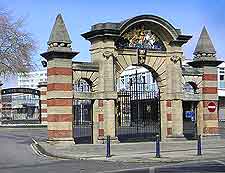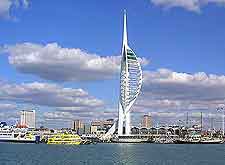Portsmouth History Facts and Timeline
(Portsmouth, Hampshire, England)
Portsmouth's history is thought to date back to the 5th century BC. At that time, it was known as Portchester.
In the 3rd century AD, the Romans started to use the town as a naval station. The town's strategic role as a major naval base continues to this day.

A Medieval Port
In 1180, a wealthy Norman merchant, Jean de Gisors, purchased the Manor of Buckland on Portsea Island. Noticing that a sheltered inlet on the island offered refuge for ships, he founded a small town here. In 1194, Portsmouth was granted a Royal Charter. Whether or not it was handed over personally by King Richard I remains open to debate.
By the 15th century, there had been numerous French attacks on Portsmouth. It was clear that better defences were needed. These included the building of the Round Tower in 1418. In 1494, a Square Tower was built on the orders of King Henry VII. A year later, work started on a dry dock.
In the 16th century, a Castle was built at Southsea, along with two more circular forts - one at Eastney and the other on the site of Lumps Fort. All these fortifications were to be put to good use in 1545, when news arrived in Portsmouth that a vast French fleet was advancing ever closer. The famous English warship known as the Mary Rose was a victim of the battle.
Early Modern History
The English Civil War was a tumultuous time in history. Although the Royal Navy sided with Parliament, the town's Governor and commander of its soldiers was a supporter of the king. After much internal conflict, Portsmouth was blockaded by sea. Southsea Castle's guns were even used to fire on Portsmouth itself. In the end, the Parliamentarians prevailed.
During the remainder of the 17th and 18th centuries, Portsmouth prospered. In 1729, a Royal Naval Academy was established as a centre for training England's officers and cadets. New ships started to be built here again and the dockyards and fortifications were extended.

The 19th and 20th Centuries
Victorian Portsmouth quickly outgrew its boundaries, swallowing up villages for development into suburbs. Among its most famous residents were the engineer Isambard Kingdom Brunel, born here in 1806, and novelist Charles Dickens, born here in 1812.
Another prominent figure closely associated with the city is Admiral Lord Nelson. He set off from Portsmouth in 1805 onboard the HMS Victory, leading it into triumphant battle. A ceremony continues to be held onboard the restored ship each year. The ship is still technically in commission today, making it the oldest of its kind.
Portsmouth's strategic naval role meant that it saw much activity during both the First and Second World Wars. In the First World War, many soldiers and sailors left Portsmouth to head into battle. The old Gunwharf was turned into a torpedo training base. Today, this lively area is known as Gunwharf Quays. In bombing raids during the Second World War, many of the historic buildings suffered damage, including the Guildhall. Whilst some were restored, others were redeveloped during the 1960s.
In more recent times, the city of Portsmouth has hosted many naval-related events. In 1982, the remains of the Mary Rose were finally raised from the Solent, to much acclaim. In 1994, the city hosted the D-Day commemorations and its own 800th anniversary.

